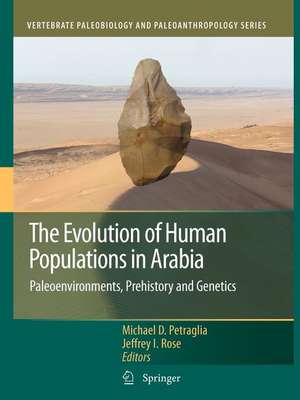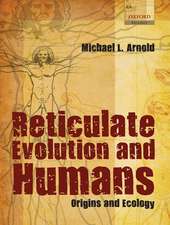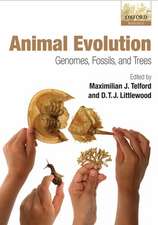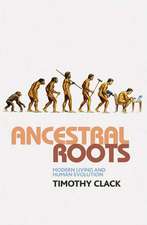The Evolution of Human Populations in Arabia: Paleoenvironments, Prehistory and Genetics: Vertebrate Paleobiology and Paleoanthropology
Editat de Michael D. Petraglia, Jeffrey I. Roseen Limba Engleză Paperback – 14 mar 2012
| Toate formatele și edițiile | Preț | Express |
|---|---|---|
| Paperback (1) | 792.19 lei 6-8 săpt. | |
| SPRINGER NETHERLANDS – 14 mar 2012 | 792.19 lei 6-8 săpt. | |
| Hardback (1) | 715.30 lei 38-45 zile | |
| SPRINGER NETHERLANDS – 11 dec 2009 | 715.30 lei 38-45 zile |
Din seria Vertebrate Paleobiology and Paleoanthropology
- 15%
 Preț: 717.13 lei
Preț: 717.13 lei -
 Preț: 314.69 lei
Preț: 314.69 lei - 15%
 Preț: 724.12 lei
Preț: 724.12 lei - 18%
 Preț: 738.34 lei
Preț: 738.34 lei - 18%
 Preț: 741.37 lei
Preț: 741.37 lei - 15%
 Preț: 719.39 lei
Preț: 719.39 lei - 18%
 Preț: 635.90 lei
Preț: 635.90 lei -
 Preț: 411.04 lei
Preț: 411.04 lei - 20%
 Preț: 606.43 lei
Preț: 606.43 lei -
 Preț: 392.60 lei
Preț: 392.60 lei - 20%
 Preț: 617.45 lei
Preț: 617.45 lei - 15%
 Preț: 650.19 lei
Preț: 650.19 lei -
 Preț: 397.38 lei
Preț: 397.38 lei - 20%
 Preț: 619.33 lei
Preț: 619.33 lei -
 Preț: 391.27 lei
Preț: 391.27 lei -
 Preț: 431.73 lei
Preț: 431.73 lei -
 Preț: 433.47 lei
Preț: 433.47 lei - 24%
 Preț: 715.30 lei
Preț: 715.30 lei -
 Preț: 449.63 lei
Preț: 449.63 lei - 24%
 Preț: 763.00 lei
Preț: 763.00 lei - 15%
 Preț: 715.31 lei
Preț: 715.31 lei - 24%
 Preț: 636.35 lei
Preț: 636.35 lei - 20%
 Preț: 631.43 lei
Preț: 631.43 lei -
 Preț: 380.72 lei
Preț: 380.72 lei - 20%
 Preț: 604.45 lei
Preț: 604.45 lei - 15%
 Preț: 708.75 lei
Preț: 708.75 lei -
 Preț: 404.29 lei
Preț: 404.29 lei - 24%
 Preț: 645.20 lei
Preț: 645.20 lei -
 Preț: 383.94 lei
Preț: 383.94 lei - 18%
 Preț: 898.13 lei
Preț: 898.13 lei -
 Preț: 403.75 lei
Preț: 403.75 lei
Preț: 792.19 lei
Preț vechi: 966.08 lei
-18% Nou
Puncte Express: 1188
Preț estimativ în valută:
151.58€ • 158.27$ • 125.46£
151.58€ • 158.27$ • 125.46£
Carte tipărită la comandă
Livrare economică 04-18 aprilie
Preluare comenzi: 021 569.72.76
Specificații
ISBN-13: 9789400731028
ISBN-10: 9400731027
Pagini: 324
Ilustrații: XII, 312 p.
Dimensiuni: 210 x 279 x 17 mm
Greutate: 0.74 kg
Ediția:2010
Editura: SPRINGER NETHERLANDS
Colecția Springer
Seria Vertebrate Paleobiology and Paleoanthropology
Locul publicării:Dordrecht, Netherlands
ISBN-10: 9400731027
Pagini: 324
Ilustrații: XII, 312 p.
Dimensiuni: 210 x 279 x 17 mm
Greutate: 0.74 kg
Ediția:2010
Editura: SPRINGER NETHERLANDS
Colecția Springer
Seria Vertebrate Paleobiology and Paleoanthropology
Locul publicării:Dordrecht, Netherlands
Public țintă
ResearchCuprins
Quaternary Environments and Demographic Response.- Tracking the Origin and Evolution of Human Populations in Arabia.- The Red Sea, Coastal Landscapes, and Hominin Dispersals.- Pleistocene Climate Change in Arabia: Developing a Framework for Hominin Dispersal over the Last 350 ka.- Environment and Long-Term Population Trends in Southwest Arabia.- Genetics and Migration.- Mitochondrial DNA Structure of Yemeni Population: Regional Differences and the Implications for Different Migratory Contributions.- The Arabian peninsula: Gate for Human Migrations Out of Africa or Cul-de-Sac? A Mitochondrial DNA Phylogeographic Perspective.- Bayesian Coalescent Inference from Mitochondrial DNA Variation of the Colonization Time of Arabia by the Hamadryas Baboon (Papio hamadryas hamadryas).- Pleistocene Archaeology.- Acheulean Landscapes and Large Cutting Tools Assemblages in the Arabian peninsula.- A Middle Paleolithic Assemblage from Jebel Barakah, Coastal Abu Dhabi Emirate.- Paleolithic Stone Tool Assemblages from Sharjah and Ras al Khaimah in the United Arab Emirates.- The Central Oman Paleolithic Survey: Recent Research in Southern Arabia and Reflection on the Prehistoric Evidence.- The Middle Paleolithic of Arabia: The View from the Hadramawt Region, Yemen.- The “Upper Paleolithic” of South Arabia.- The Late Pleistocene of Arabia in Relation to the Levant.- The Early Holocene.- Holocene (Re-)Occupation of Eastern Arabia.- Early Holocene in the Highlands: Data on the Peopling of the Eastern Yemen Plateau, with a Note on the Pleistocene Evidence.- Southern Arabia’s Early Pastoral Population History: Some Recent Evidence.- Archaeological, Linguistic and Historical Sources on Ancient Seafaring: A Multidisciplinary Approach to the Study of Early Maritime Contact and Exchange inthe Arabian Peninsula.- Holocene Obsidian Exchange in the Red Sea Region.- Synthesis and Discussion.- The Paleolithic of Arabia in an Inter-regional Context.
Recenzii
From the reviews:
“This final published set expands significantly beyond that initial purpose to add significant context to what is admittedly still a largely Palaeolithic focus. … The quality of the papers contained within the volume is very high indeed. … This volume provides an excellent statement of our current state of knowledge of the Pleistocene and Early Holocene occupation of the Arabian Peninsula … also setting the scene for future research to address the new-found archaeological complexity of this region.” (Anthony Sinclair, Bulletin of the Society for Arabian Studies, April, 2010)
“This latest volume in Springer’s ‘Vertebrate Paleobiology and Paleoanthropology’ series is essentially a compilation of discrete research papers. Collectively, they provide a comprehensive, albeit repetitious, review of Arabian prehistory. … Summing Up: Recommended. Archaeology and anthropology collections serving graduate students and researchers/faculty.” (D. A. Brass, Choice, Vol. 47 (11), July, 2010)
“This final published set expands significantly beyond that initial purpose to add significant context to what is admittedly still a largely Palaeolithic focus. … The quality of the papers contained within the volume is very high indeed. … This volume provides an excellent statement of our current state of knowledge of the Pleistocene and Early Holocene occupation of the Arabian Peninsula … also setting the scene for future research to address the new-found archaeological complexity of this region.” (Anthony Sinclair, Bulletin of the Society for Arabian Studies, April, 2010)
“This latest volume in Springer’s ‘Vertebrate Paleobiology and Paleoanthropology’ series is essentially a compilation of discrete research papers. Collectively, they provide a comprehensive, albeit repetitious, review of Arabian prehistory. … Summing Up: Recommended. Archaeology and anthropology collections serving graduate students and researchers/faculty.” (D. A. Brass, Choice, Vol. 47 (11), July, 2010)
Notă biografică
Michael D. Petraglia was born in New York in 1960. He is currently a Senior Lecturer in the Leverhulme Centre for Human Evolutionary Studies, University of Cambridge. Over the past 25 years, he has conducted archaeological research in India, Arabia, Europe and North America. He is co-editor of the book, The Evolution and History of Human Populations in South Asia (Springer).
Jeffrey Ian Rose was born in Princeton, New Jersey in 1975. Over the past 20 years, he has conducted fieldwork in prehistoric archaeology throughout North America, Europe, and Arabia. He is currently a Senior Lecturer in the Department of Anthropology and Geography at Oxford Brookes University and runs an ongoing archaeological research project in the Sultanate of Oman.
Jeffrey Ian Rose was born in Princeton, New Jersey in 1975. Over the past 20 years, he has conducted fieldwork in prehistoric archaeology throughout North America, Europe, and Arabia. He is currently a Senior Lecturer in the Department of Anthropology and Geography at Oxford Brookes University and runs an ongoing archaeological research project in the Sultanate of Oman.
Textul de pe ultima copertă
The contemporary deserts of Arabia form some of the most dramatic arid landscapes in the world; yet, during many times in the past, the region was well-watered, containing evidence for rivers and lakes. Climatic fluctuations through time must have had a profound effect on human population that lived and passed through the region. In this book, paleoenvironmental specialists, archaeologists and geneticists are brought together to provide a comprehensive account of the evolution of human populations in Arabia. A wide range of topics are explored in this book, including environmental change and its impact on human populations, the movement and dispersal of populations through the region, and the origin and spread of food producing economies. New theories and interpretations are presented which provide new insights into the evolution of human populations in a key region of the world.
Caracteristici
First book on prehistory of Arabia Includes multidisciplinary subjects such as paleoenvironments, archaeology, genetics and linguistics Provides a more comprehensive picture about human adaptations and population changes Presents new theories and methodologies providing new interpretations about cultural history and evolution of populations in Arabia Includes supplementary material: sn.pub/extras
















